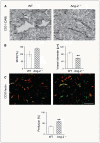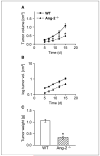Host-derived angiopoietin-2 affects early stages of tumor development and vessel maturation but is dispensable for later stages of tumor growth
- PMID: 19208839
- PMCID: PMC3514474
- DOI: 10.1158/0008-5472.CAN-08-3030
Host-derived angiopoietin-2 affects early stages of tumor development and vessel maturation but is dispensable for later stages of tumor growth
Abstract
The angiopoietin/Tie2 system has been identified as the second vascular-specific receptor tyrosine kinase system controlling vessel assembly, maturation, and quiescence. Angiopoietin-2 (Ang-2) is prominently up-regulated in the host-derived vasculature of most tumors, making it an attractive candidate for antiangiogenic intervention. Yet, the net outcome of Ang-2 functions on tumor angiogenesis is believed to be contextual depending on the local cytokine milieu. Correspondingly, Ang-2 manipulatory therapies have been shown to exert protumorigenic as well as antitumorigenic effects. To clarify the role of Ang-2 for angiogenesis and tumor growth in a definite genetic experimental setting, the present study was aimed at comparatively studying the growth of different tumors in wild-type and Ang-2-deficient mice. Lewis lung carcinomas, MT-ret melanomas, and B16F10 melanomas all grew slower in Ang-2-deficient mice. Yet, tumor growth in wild-type and Ang-2-deficient mice dissociated during early stages of tumor development, whereas tumor growth rates during later stages of primary tumor progression were similar. Analysis of the intratumoral vascular architecture revealed no major differences in microvessel density and perfusion characteristics. However, diameters of intratumoral microvessels were smaller in tumors grown in Ang-2-deficient mice, and the vasculature had an altered pattern of pericyte recruitment and maturation. Ang-2-deficient tumor vessels had higher pericyte coverage indices. Recruited pericytes were desmin and NG2 positive and predominately alpha-smooth muscle actin negative, indicative of a more mature pericyte phenotype. Collectively, the experiments define the role of Ang-2 during tumor angiogenesis and establish a better rationale for combination therapies involving Ang-2 manipulatory therapies.
Figures






Similar articles
-
Weibel-Palade Bodies Orchestrate Pericytes During Angiogenesis.Arterioscler Thromb Vasc Biol. 2019 Sep;39(9):1843-1858. doi: 10.1161/ATVBAHA.119.313021. Epub 2019 Jul 18. Arterioscler Thromb Vasc Biol. 2019. PMID: 31315435
-
Tumor-derived vascular endothelial growth factor up-regulates angiopoietin-2 in host endothelium and destabilizes host vasculature, supporting angiogenesis in ovarian cancer.Cancer Res. 2003 Jun 15;63(12):3403-12. Cancer Res. 2003. PMID: 12810677
-
Differential expression of angiopoietin-1 and angiopoietin-2 may enhance recruitment of bone-marrow-derived endothelial precursor cells into brain tumors.Neurol Res. 2005 Dec;27(8):801-6. doi: 10.1179/016164105X49319. Neurol Res. 2005. PMID: 16354539
-
Angiopoietin-1 and -2 exert antagonistic functions in tumor angiogenesis, yet both induce lymphangiogenesis.Cancer Res. 2011 Sep 1;71(17):5717-27. doi: 10.1158/0008-5472.CAN-10-4635. Epub 2011 Jul 21. Cancer Res. 2011. PMID: 21778249
-
The NG2 Proteoglycan in Pericyte Biology.Adv Exp Med Biol. 2018;1109:5-19. doi: 10.1007/978-3-030-02601-1_2. Adv Exp Med Biol. 2018. PMID: 30523586 Review.
Cited by
-
Pericytes on the tumor vasculature: jekyll or hyde?Cancer Microenviron. 2013 Apr;6(1):1-17. doi: 10.1007/s12307-012-0102-2. Epub 2012 Mar 31. Cancer Microenviron. 2013. PMID: 22467426 Free PMC article.
-
Dual targeting of Angiopoetin-2 and VEGF potentiates effective vascular normalisation without inducing empty basement membrane sleeves in xenograft tumours.Br J Cancer. 2015 Feb 3;112(3):495-503. doi: 10.1038/bjc.2014.629. Epub 2015 Jan 6. Br J Cancer. 2015. PMID: 25562438 Free PMC article.
-
Effects of vascular-endothelial protein tyrosine phosphatase inhibition on breast cancer vasculature and metastatic progression.J Natl Cancer Inst. 2013 Aug 21;105(16):1188-201. doi: 10.1093/jnci/djt164. Epub 2013 Jul 30. J Natl Cancer Inst. 2013. PMID: 23899555 Free PMC article.
-
Effects of angiopoietin-2-blocking antibody on endothelial cell-cell junctions and lung metastasis.J Natl Cancer Inst. 2012 Mar 21;104(6):461-75. doi: 10.1093/jnci/djs009. Epub 2012 Feb 17. J Natl Cancer Inst. 2012. PMID: 22343031 Free PMC article.
-
Targeting Tie2 in the Tumor Microenvironment: From Angiogenesis to Dissemination.Cancers (Basel). 2021 Nov 16;13(22):5730. doi: 10.3390/cancers13225730. Cancers (Basel). 2021. PMID: 34830883 Free PMC article. Review.
References
-
- Jemal A, Murray T, Ward E, et al. Cancer statistics, 2005. CA Cancer J Clin. 2005;55:10–30. - PubMed
-
- Kesisis G, Broxterman H, Giaccone G. Angiogenesis inhibitors. Drug selectivity and target specificity. Curr Pharm Des. 2007;13:2795–809. - PubMed
-
- Ng YS, Krilleke D, Shima DT. VEGF function in vascular pathogenesis. Exp Cell Res. 2006;312:527–37. - PubMed
-
- Baka S, Clamp AR, Jayson GC. A review of the latest clinical compounds to inhibit VEGF in pathological angiogenesis. Expert Opin Ther Targets. 2006;10:867–76. - PubMed
-
- Maisonpierre PC, Suri C, Jones PF, et al. Angiopoietin-2, a natural antagonist for Tie2 that disrupts in vivo angiogenesis. Science. 1997;277:55–60. - PubMed
Publication types
MeSH terms
Substances
Grants and funding
LinkOut - more resources
Full Text Sources
Other Literature Sources
Medical
Molecular Biology Databases
Miscellaneous

